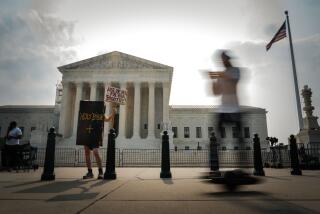Guilty of confusion
THE SUPREME COURT has obligations both to society and to the law. In its end-of-term rush last week, it served neither well, shirking its duties in rulings that undermined free speech, made it easier for a president to violate the Constitution’s prohibition against funding religion and transformed the meaning of the 20th century’s most important case, Brown vs. the Board of Education, from a call to an integrated society into a bar against that goal.
At its best, the Supreme Court acts as more than a body of judges. It supplies legal and ethical leadership to a divided nation, guiding by the strength of its logic, educating the populace as it interprets and makes law. Nowhere was that more evident than in the original Brown decision. In 1954, Chief Justice Earl Warren wrote simply and plainly, and he kept the opinion short in part so that newspapers would reprint it. He did so because he recognized that his mission was not just to change the law permitting segregated schools but to convince a nation that the court’s logic was so sturdy that it must be obeyed.
Contrast that with these recent rulings. The speech, religion and school cases were ganged together at the end of the term, hindering the public from deliberately examining each on its merits. That alone inhibits understanding. So do the decisions themselves. The free-speech case came down 5 to 4. The ruling on government support for religion was written by Chief Justice John G. Roberts Jr. on behalf of just himself and two other justices, with two more joining only in the result, not the reasoning. And in the most significant school segregation case in years? Roberts wrote for four justices; four others dissented, while Justice Anthony M. Kennedy hedged his bets. The consequence was uncertainty about where the law stands and a public more confused than ever.
A court united behind coherent principles encourages public trust in the law, as it did in Brown. There, nine justices supported a single ruling that ran just 10 pages — no dissents, no concurrences — and shined a beacon of clarity. Half a century later, the court’s main opinion reinterpreting Brown was accompanied by two concurrences and attracted two dissents. The opinions covered 178 pages, along with charts, graphics and appendices. The court’s work was long on detail, and devoid of leadership.
More to Read
A cure for the common opinion
Get thought-provoking perspectives with our weekly newsletter.
You may occasionally receive promotional content from the Los Angeles Times.






